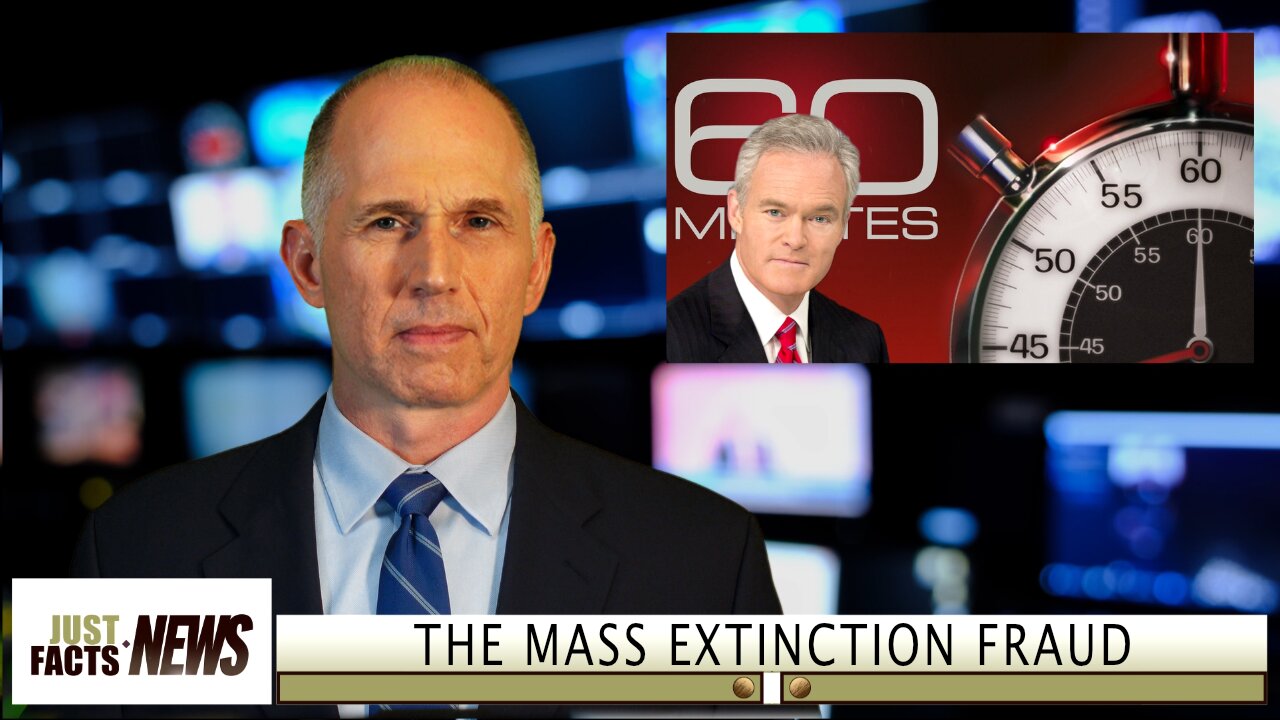Premium Only Content

The Mass Extinction Fraud
Contrary to 60 Minutes, the facts are overwhelming that earth isn’t in the midst of an “extinction crisis.”
SOURCES:
On 1/1/23, 60 Minutes reported, “A World Wildlife Fund study says that in the past 50 years, the abundance of global wildlife has collapsed 69%.” https://www.cbsnews.com/news/earth-mass-extinction-60-minutes-2023-01-01/
The World Wildlife Fund study cited by 60 Minutes is based on its “Living Planet Index.”
https://wwflpr.awsassets.panda.org/downloads/lpr_2022_full_report.pdf#page=18
Scholars in academic journals have documented that the Living Planet Index (LPI) “does not measure abundance.” Yet, the World Wildlife Fund claims that it does and receives “high media coverage” that makes the “common mistake of interpreting the LPI as measuring abundance loss.”
https://leung-lab.github.io/leunglab/articles/Leung_2022_601a.pdf
https://wwflpr.awsassets.panda.org/downloads/lpr_2022_full_report.pdf#page=18
The claim that the Living Planet Index shows a “mean vertebrate decline of more than 50% since 1970” is “driven by less than 3% of vertebrate populations,” while “no global trend remained across typical populations.” https://www.nature.com/articles/s41586-020-2920-6
A study using the world’s largest database of long-term species abundances found, “Most populations (85%) did not show significant trends in abundance, and those that did were balanced between winners (8%) and losers (7%).” https://onlinelibrary.wiley.com/doi/abs/10.1111/ele.13242
The figure of “up to 100 times” from Barnosky’s research actually “varied from 8 to 100 times.” https://www.science.org/doi/10.1126/sciadv.1400253
A Cambridge University Press book on biodiversity explains that no “serious” attempt has been made to “judge the reliability” of extinction rates based on fossils because the “uncertainties at each stage of the calculation” would make the effort worthless. Thus, the book states, “Probably no one will be surprised if this estimate is off by a factor of 10 or even 100.” https://www.amazon.com/Biodiversity-Environmental-Philosophy-Introduction-Cambridge-ebook/dp/B000SHMQES
Barnosky’s research counts all “617” vertebrae species that have become extinct or “possibly extinct” since 1500. https://www.science.org/doi/10.1126/sciadv.1400253
An academic journal documents that 95% of bird and mammal extinctions since 1500 “were on islands.” Thus, “it is useful to consider islands as a special case” because species have “smaller geographic ranges” and other differences that make them more prone to extinction than continental species. https://onlinelibrary.wiley.com/doi/full/10.1111/j.1472-4642.2011.00856.x
Per the textbook Conservation and Ecology, “The estimates of the background extinction rate” from fossils “derive from the abundant and widespread species that dominate the fossil record. By contrast, the species most likely to become extinct today are rare and local.” https://www.amazon.com/Conservation-Ecology-Living-Earth-Rafferty/dp/1615303073
Per the textbook Vertebrate Paleontology and Evolution, “A particularly important bias of the fossil record is expressed against organisms that are rare and/or geographically restricted.” https://www.amazon.com/Vertebrate-Paleontology-Evolution-Robert-Carroll/dp/0716718227
A 2011 paper in the journal Diversity and Distributions revealed that “only six continental birds and three continental mammals were recorded in standard databases as going extinct since 1500 compared to 123 bird species and 58 mammal species on islands.” https://onlinelibrary.wiley.com/doi/full/10.1111/j.1472-4642.2011.00856.x
A 2015 paper in the journal Science disclosed that there were “only 15 global extinctions of marine animal species in the past 514 years” and “none in the past five decades.” https://www.science.org/doi/10.1126/science.1255641
A paper in the journal Endangered Species Research by an Australian scientist states that certain scientists overstate “the risks of wildlife becoming extinct” by using “deliberate and gross” exaggerations. The paper also states that scientists who designate species as “endangered” are “often beneficiaries” of funding that flows as a result of these designations. Thus, “the potential for self-serving assessments has long been recognized.” http://www.int-res.com/articles/esr2008/6/n006p161.pdf
The scientists who authored the paper in the journal Diversity and Distributions state, “Our results do not support statements or projections by others of grossly elevated extinction rates for continental bird and mammal fauna over the last 500 years compared with background rates.” https://onlinelibrary.wiley.com/doi/full/10.1111/j.1472-4642.2011.00856.x
In 1977, President Jimmy Carter tasked the EPA, State Department, National Science Foundation, and several other federal agencies to produce a “study of the probable changes” to the “world’s population, natural resources, and environment” up through the year 2000. This turned into a herculean effort, involving hundreds of people, including “informal advisors” to the study representing the world’s leading environmental institutions. https://www.justfacts.com/document/global_2000_report_president_carter_1979.pdf#page=4
In 1979, the dream team of scientists released The Global 2000 Report to the President of the U.S., which stated that “at least 500,000–600,000” species “will be extinguished during the next two decades” under “continued technological progress” and “no departures from present public policy.” https://www.justfacts.com/document/global_2000_report_president_carter_1979.pdf#page=357
In 2004, the International Union for Conservation of Nature reported, “At least 27 species are recorded as having become Extinct or Extinct in the Wild during the last 20 years (1984–2004). … For example, eight species of birds are thought to have become Extinct or Extinct in the Wild over the past 20 years, but they are not included, as further research is needed prove the last individual has died.” https://portals.iucn.org/library/sites/library/files/documents/RL-2004-001.pdf
The Global 2000 Report to the President of the U.S. states, “How many extinctions are implied by the Global 2000 Study’s forestry projections? An estimate was prepared for the Global 2000 Study by Thomas E. Lovejoy of the World Wildlife Fund.” https://www.justfacts.com/document/global_2000_report_president_carter_1979.pdf#page=353
The 60 Minutes footage from CBS is reproduced under the fair use provision of U.S. copyright law for “purposes such as criticism” and “comment” (17 U.S.C. §107). https://www.law.cornell.edu/uscode/text/17/107
-
 9:42
9:42
Just Facts
2 months agoMargins of Error
5.2K1 -
 8:12:48
8:12:48
XxXAztecwarrior
9 hours agoKilling Little Timmy's On Verdansk
66.3K3 -
 4:53:16
4:53:16
SynthTrax & DJ Cheezus Livestreams
1 day agoFriday Night Synthwave 80s 90s Electronica and more DJ MIX Livestream THE NEW MODEL - Variety Edition
57.9K10 -
 LIVE
LIVE
Anthony Rogers
1 day agoAnthony Rogers Show - 24/7 Stream
488 watching -
 2:11:55
2:11:55
Total Horse Channel
19 hours ago2025 CMSA Extravaganza | Mounted Shooting
58.3K3 -
 4:50:33
4:50:33
VapinGamers
10 hours ago $5.32 earnedGedonia 2 - Early Release Preview and Co-Stream! - !game #Sponsored
69.2K -
 1:32:39
1:32:39
Glenn Greenwald
15 hours agoWeek in Review: Trump's Tariffs, Ukraine Negotiations, Possibility of War with Iran, and More with Glenn Greenwald, Lee Fang, & Michael Tracey | SYSTEM UPDATE #438
151K70 -
 5:01:00
5:01:00
EnDuEnDo
9 hours ago🚨Vairety Stream 🎮 Push to 500 Followers 🚀 Chill Vibes 😎
32.5K1 -
 4:25:53
4:25:53
Nerdrotic
15 hours ago $40.78 earnedMarvel Is SCREWED | Daredevil Afterbirth | G20 is ABSOLUTE Cinema - Friday Night Tights 349 w MauLer
149K36 -
 56:03
56:03
BonginoReport
14 hours agoICE Boss Wants Deportations To Run like Amazon Prime - Nightly Scroll w/Hayley Caronia (Ep.25)
148K87